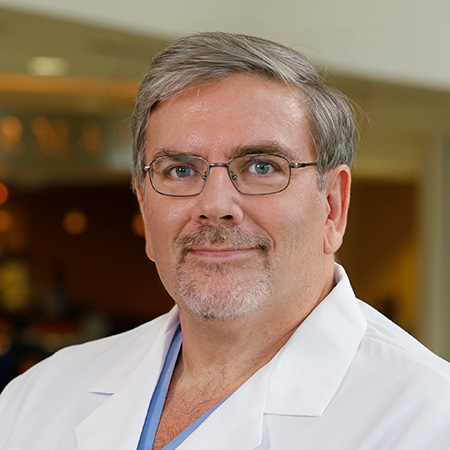
Patients in the Richmond, Virginia, area now have access to robotic-assisted bronchoscopy, a cutting-edge technology designed to improve the diagnostic capability of lung biopsies. Daniel Woolley, MD, is a board-certified and fellowship-trained cardiothoracic surgeon with Cardiothoracic Surgical Associates who specializes in minimally-invasive robotic surgery and is one of the first in the area to offer access to this advanced procedure at Chippenham Hospital.
What is robotic-assisted bronchoscopy?
While most lung nodules are benign, or non-cancerous, a biopsy may be recommended to help confirm a diagnosis. A lung biopsy involves removing a tissue sample from the suspicious area of the lung and examining it under a microscope to look for cancer or other diseases. Many times, these suspicious nodules are found in the peripheral airways of the lungs, making them difficult to reach using traditional bronchoscopy techniques.
Robotic-assisted bronchoscopy allows Dr. Woolley to connect the patient’s prior computed tomography (CT) scans with the robotic software and develop a precise, personalized pathway to the pulmonary nodule before surgery even begins. The software allows him to able to use three-dimensional (3D), high-resolution imaging as a road map to robotically navigate the through the airways to the site of the nodule. Once at the site, he is able to minimally-invasively extract the tissue sample for biopsy.
A typical robotic-assisted bronchoscopy procedure takes four to six hours and is often done as an outpatient procedure.
Who is a candidate for robotic-assisted bronchoscopy?
Most patients who have been diagnosed with a lung nodule or mass are eligible for robotic-assisted bronchoscopy. The procedure is used to aid surgeons in obtaining tissue samples for biopsy in order to determine if the nodule or mass is cancerous or has markers for other lung conditions. Factors that influence the decision to use traditional versus robotic bronchoscopy include the patient’s health, physical characteristics of the nodule, and the location of the nodule within the airway.
Advantages of robotic-assisted bronchoscopy
Robotic-assisted bronchoscopy has several advantages over traditional, CT-guided bronchoscopy procedures. The combined effect is improved accuracy in diagnosing and staging cancer and other lung disorders, thus getting patients into treatment sooner. Additional advantages include:
- Flexibility – Using robotic-assisted bronchoscopy, Dr. Woolley robotically controls a thin, maneuverable catheter that reaches deep into the peripheral airways of the lungs where traditional surgical instruments may not be able to go. The catheter has the ability to rotate in any direction and is flexible enough for the surgeon to guide it through the tightest of turns.
- Advanced imaging – In addition to targeting the original nodule, 3D real-time imaging provides the advanced optics needed for the surgeon to see additional pulmonary lesions and to obtain tissue samples both inside and outside of the airways. This potentially eliminates the need for additional biopsy surgeries and provides greater confidence in making a diagnosis.
- Stability – The thin, flexible catheter tube is incredibly stable, allowing the surgeon to easily navigate through even the smallest airways with greater precision and accuracy than manual surgical methods. The result is the ability to safely extract a larger tissue sample from the targeted lesion than manual methods allow.
- Reduced surgical complications – Robotically-assisted bronchoscopy typically results in fewer complications, including collapsed lungs and airway bleeding.
- Improved diagnostics – A robotic-assisted bronchoscopy provides precise, pinpointed accuracy in a single procedure versus conventional techniques that may require additional, more invasive surgeries to reach the lesion. The robotic procedure often provides a more rapid diagnosis that advances patients into the treatment phase of their care more quickly.
Advanced clinical outcomes
The most significant benefit of having robotically-guided bronchoscopy versus traditional bronchoscopy is the advancement in clinical outcomes for the patient. According to the American Cancer Society, “Lung cancer is by far the leading cause of cancer death in the U.S., accounting for about one in five of all cancer deaths.” Early detection and treatment significantly increase the lung cancer survival rate.
Robotic-assisted bronchoscopy is an innovative technology that allows surgeons to overcome the challenge of reaching lesions deep within the lungs, where the majority of nodules are found. The extreme flexibility and stability of the robotic catheter tube, in combination with a highly-magnified view of the airways, now makes it possible to reach suspicious nodules that used to be inaccessible. The result? A faster, highly accurate diagnosis that translates into more immediate treatment for the patient.
By integrating robotic-assisted bronchoscopy into the surgical suite, Dr. Woolley is able to visualize the entire airway, biopsy multiple lesion sites if needed, and develop a personalized treatment plan based on his findings. Patients receive state-of-the-art care that gives them the best possible clinical outcome for their condition.
Risks and benefits
Minimally-invasive, robotic-assisted bronchoscopy surgery is an accurate and safe method of obtaining tissue samples for biopsy. When compared with traditional surgical biopsy methods, benefits of robotic-assisted bronchoscopy include:
- fewer complications and damage to surrounding lung tissue.
- faster recovery time.
- reduction in postoperative pain.
- less scarring.
- less blood loss.
- fewer subsequent biopsy surgeries.
- improved diagnostic accuracy.
All surgeries have some risk but, in general, those associated with robotic-assisted bronchoscopy are few. Potential risks include:
- coughing during and after the procedure as a result of the catheter tube being inserted through the vocal cords.
- a sore throat that usually subsides within a few days.
- an infection.
- bleeding at the biopsy site.
- pneumothorax, the clinical name for a collapsed lung.
- a hole in the airway.
Dr. Woolley will discuss the risks and benefits of robotic-assisted bronchoscopy versus traditional methods, so that patients can make an informed decision for themselves.
For more information and to schedule an appointment with Dr. Woolley, call (804) 320-2751 or book online.